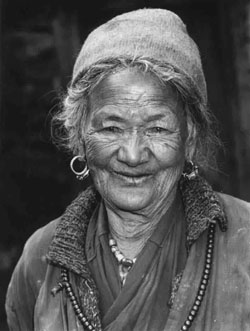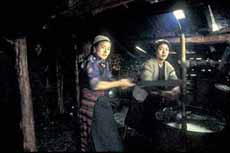|
OBJECTIVE
• To help students understand the nomadic lifestyle
of Himalayan nomads and the impact of circular
migration on villages.

http://natureproducts.net/Art/Gabrielle/sun_moon_mountain.html
TIME NEEDED FOR LESSON
• 30 minutes for preview and vocabulary
• 85 minutes for film
• 45 minutes for discussion and recording
• 60 minutes for murals
• 30 minutes for mural observations, follow up discussions
and sharing of journal entries

PRIOR KNOWLEDGE NEEDED
• Geography of Nepal and India: especially locations
of Kathmandu, Melemchi, and bordering villages of India
• Background information on the Film: Himalayan Herders,
by Naomi and John Bishop (See A
Day in the Gode)
• Teachers may do additional background reading of Himalayan
Herders (Naomi H. Bishop) (Thomson Custom Publishing) (ISBN:
0-534-44060-6)

MATERIALS
• Film: Himalayan
Herders, by Naomi and John Bishop
(Order from )
• Vocabulary List
• Section Discussion Questions
• Mural Supplies

VOCABULARY LIST
• Gode - (pronounced GO-day) - a temporary
shelter (constructed from bamboo mats over a framework of poles)
in which herding families live
• Gomba - a Buddhist temple
• Zomo - cow-yak hybrids, thriving in Himalayan
pastures between 2134-4000 m. altitude
• Fodor - feed for livestock, especially
coarsely chopped hay or straw
• Cremation - the process of incinerating
a dead body.
• Circular Migration - movement to and from
a village, sometimes to faraway places, in search of finding additional
sources of income
• Bombos - shamans who manage day-to-day
spiritual and medical problems in the villages
• Kata - a special ceremonial scarf offered
during traditional ceremonies, such as weddings

PROCEDURE
• Divide class into groups
of 3
• Preview movie with A Day in the Gode discussion
• Distribute "Section Questions" to the groups (some
sections may be given to more than 1 group)
- ask students to read their questions prior to the film so
that they know what to look for
• Show film, stopping at key moments for discussion or clarification
• Have students meet in groups to discuss questions and record
their findings
• Using 3 sheets of 8" by 10" paper, have each student
in every group choose and illustrate a piece of their section of
the film
• Lastly, have students assemble their illustrations into
one giant mural and discuss the overall product with the class

SECTION QUESTIONS
Section I
• Describe 5 physical characteristics of Melemchi.
• Tell 5 facts about about life in a gode - describe 5 features
of what day-to-day life is like.
• Name 3 ways in which life for the women of Melemchi is
especially hard.
• What are two major uses of butter in this village?
Section II
• Describe the reason for fodor gathering? Name
5 steps of the process.
• What are 5 staple crops of Melemchi?
• Name 3 ways in which villagers obtain food and items that
they do not produce themselves.
• How is fair trade established amongst different
groups?
Section III
• Aside from farming and herding, what other ways (describe
5) do the people of Melemchi make a living?
• Describe 5 elements of the process of how people traded sheep
prior to 1950.
• Name 3 advantages of circular migration.
• Name 3 disadvantages of circular migration.
Section IV
• How has the creation of the national park attributed to an
increase in circular migration?
• Describe 5 possible situations one might encounter during
migration.
• Describe 5 characteristics of a death ceremony shown in the
film.
Section V
• Describe in detail 10 things that happen during the Nara
Festival in early July
• Describe, in three ways, the schools that the government
set up in the village
• Name 5 ways in which life has changed for people in Melemchi.
• How do the elders feel about the future? What new ways are
they finding to survive?

HOMEWORK
• Journal entry: From the perspective of
an elder in Melemchi, write a 2-page description of how you feel
about the changes taking place. Be sure to include factual details
in your work
OR
• Journal entry: From the perspective of a circular migrator
in Melemchi, write a 2-page description of how you feel about the
changes taking place. Be sure to include factual details in your
work
|


